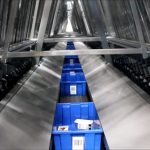It’s always crucial to make the best use of your warehouse’s available floor space. However, as storage density grows, it takes longer to place and remove unit loads when they are needed.
There are several high-density storage alternatives available, but they differ in how quickly the pallets may be reached; the optimum option will vary depending on your operation and individual demands. The most effective way to achieve dense, compact pallet storage in automating warehouse is the pallet shuttle/flow rack system.
Achieving Dense, Compact Pallet Storage with Pallet Shuttle System
Compact storage solutions maximize available warehouse area, resulting in increased storage density. As an electric shuttle carries items along the channel automatically, the pallet shuttle system is the one that improves an installation’s productivity the most.
The pallet shuttle system is the best answer for firms that need to increase storage space while simultaneously enhancing efficiency due to its combination of compactness and material handling automation.
Advantages of Pallet Shuttle System for Effective Storage
Traditional solutions (drive-in, push-back, live or semi-automatic Pallet Shuttle racking) and automated solutions (drive-in, push-back, live or semi-automatic Pallet Shuttle racking) are among the high-density systems available (Pallet Shuttle system with stacker cranes or transfer cars).
These all have their own distinct characteristics, benefits, and applications, but they all have a few things in common:
- They maximize warehouse space by lowering the number of aisles and, as a result, achieving better storage capacity.
- In traditional solutions, counterbalanced forklifts and reach trucks are used to handle items.
- They only allow direct access to the pallet that coincides with the working aisle.
- The same SKU is assigned to each lane (in the drive-in racks) or each level of a lane (in the push-back, live, and Pallet Shuttle racks).
- They’re frequently utilized to keep many pallets of the same SKU together.
Double-Deep Racking
In this system, pallets are kept in two-deep racks rather than one-deep racks. This means that four pallets can be kept between two aisles instead of two. This means you can make better use of the space you have compared to traditional racking.
Special trucks with telescoping prongs capable of reaching the back pallet must be used, and each SKU should have at least two pallets; otherwise, merchandise will have to be shuffled around while the back pallet is being retrieved.
The Interlake Mecalux Pallet Flow is a space-saving design that can hold up to four pallets deep. Wheel track pieces are put on a sloped lane, and pallets move from the entering side to the picking side, resulting in a first in, first out (FIFO) system.
Pallets enter at the top of the wheel track and slide down by gravity to the bottom, where they will be ready for selection.
Having separate loading and unloading aisles cuts down on handling time and prevents aisle congestion, allowing forklift trucks to deposit and remove pallets without interruption. Each flow lane can also be labeled with a particular SKU, allowing for simple access to a wide range of products, which was vital to any warehouse.
Pallet Flow is especially useful in holding warehouses and dispatch areas where employees must quickly remove pallets. Also, Pallet Flow enables for optimum product turnover because it is a first in, first out system.
This keeps the front pallet position full at all times and simplifies pallet removal. In addition, based on the unique flow rates and order picking needs, Interlake Mecalux Pallet Flow systems allow an endless range of layouts.
Drive-In Racking
Rather than driving alongside the racking in an aisle, forklifts enter the racking to place and receive pallets with this technique. Drive-in racking has a lot of density, but it also has a lot of selectivity. As a result, it’s commonly seen in cold stores, where space is limited and operating expenses are high.
Benefits of The Combination of High-Density Racking and The Pallet Shuttle
- High-density racking increases pallet storage capacity by working with channels depth-wise, eliminating aisle space.
- The adaptability of both systems makes them suited to all sorts of installations: refrigerated warehouses, dangerous products warehouses, bulky goods warehouses, etc.
- Pallet Shuttles provide rapid stock rotation according to established FIFO or LIFO standards.
- The Pallet Shuttle, when used in conjunction with compact systems, reduces the number of manual movements.
Useful Tips for Increasing Warehouse Optimization
Sort your SKUs into several product groups
- Examine average inventory levels and forecasted increase by SKU.
- For each SKU in your facility, don’t forget to add the unit of measurement (pallets, cases, etc.).
- Take into account other variables—do you have any perishable items or items that need to be refrigerated? Is it necessary to use specialized material handling equipment to transport particular products?
Sort each product category into activity groups
- You might categorize the groups based on the number of shipments or picks involved over time.
- Select an activity metric that is appropriate for your warehouse.
Establish how quickly each SKU is moved
- For example, letters can be used to represent movement velocity. Use “A” to represent the fastest and “C” to represent the slowest.
Allocating warehouse space
- Prioritize depending on the SKU’s combination of each piece when allocating warehouse space. You might have one space for pallets and another for cases, for example.
- Store your SKUs with the highest turn rates together in the most accessible areas, such as near the shipping doors and at ground level.
Do you want to learn more about which dense storage system is right for you? For comprehensive guidance on Interroll warehouse storage equipment’s, call us today.
We’ll help you go through some more high-density systems and compare them in terms of initial investment, handling costs, handling capacity, and space utilization.


